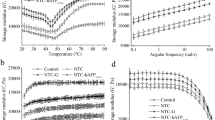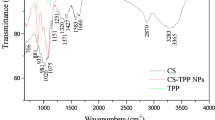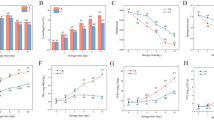Abstract
The effects on the quality of frozen red sea bream which were pretreated by soaking in solutions containing trehalose, chitosan magnetic nanoparticles (CS@Fe3O4 nanoparticles), and glycerin or different concentration herring antifreeze proteins (AFPs) were investigated in this study. The DSC, dynamic rheology, shear force, and TPA were conducted to analyze the physical characteristics. Raman and intrinsic fluorescence spectra were used to measure the protein secondary and tertiary structures. So-ANS and zeta potential were carried out to explore the degree of protein aggregation. Low-field NMR was used to test the water migration, and light microscope was performed to observe the fiber microstructure. Results showed that prior to freezing, the pretreatment of red sea bream samples with soak solutions could minimize drip loss, preserve the meat tenderness and texture, and improve the fish fillet thermal stability and viscoelasticity, and the free water content was decreased while the immobilized water content was increased; the longitudinal and transverse fiber structures were clear and less destructive. Compared with the control, the protein secondary and tertiary structures of samples, among the tested soaking solutions, tended to stability, and the degree of protein oxidation and aggregation was decreased. Therefore, this methodology was proved to be an effective method to inhibit the ice crystal growth and modify ice crystal form in order to improve the quality of the final product, and these effects were amplified with the concentration of AFPs increasingly.




Similar content being viewed by others
References
Bar, D. M., Braslavsky, I., & Davies, P. L. (2016). Ice-binding proteins and their function. Annual Review of Biochemistry, 85, 515–542.
Beliciu, C. M., & Moraru, C. I. (2011). The effect of protein concentration and heat treatment temperature on micellar casein-soy protein mixtures. Food Hydrocolloids, 25(6), 1448–1460.
Bhat, F. M., & Riar, C. S. (2017). Studies on effect of temperature and time on textural and rheological properties of starch isolated from traditional rice cultivars of Kashmir. Journal of Texture Studies, 48(2), 151–159.
Cai, L. Y., Cao, M. J., Cao, A. L., Regenstein, J., Li, J. R., & Guan, R. F. (2018). Ultrasound or microwave vacuum thawing of red seabream (Pagrus major) fillets. Ultrasonics Sonochemistry, 47, 122–132.
Cao, Y., & Xiong, Y. L. (2015). Chlorogenic acid-mediated gel formation of oxidatively stressed MP. Food Chemistry, 180, 235–243.
Cao, M. J., Cao, A. L., Wang, J., Cai, L. Y., Regenstein, J., Ruan, Y. J., & Li, X. X. (2018). Effect of magnetic nanoparticles plus microwave or far-infrared thawing on protein conformation changes and moisture migration of red seabream (Pagrus major) fillets. Food Chemistry, 266, 498–507.
Carew, E. B., Asher, I. M., & Stanley, H. E. (1975). Laser raman spectroscopy--new probe of myosin substructure. Science, 188(4191), 933–936.
Cosminm, B., & Carmeni, M. (2011). The effect of protein concentration and heat treatment temperature on micellar casein-soy protein mixtures. Food Hydrocolloids, 25(6), 1448–1460.
Davies, P. L. (2014). Ice-binding proteins: a remarkable diversity of structures for stopping and starting ice growth. Trends in Biochemical Sciences, 39(11), 548–555.
Ding, X., Zhang, H., Wang, L., Qian, H., Qi, X., & Xiao, J. (2015). Effect of barley antifreeze protein on thermal properties and water state of dough during freezing and freeze-thaw cycles. Food Hydrocolloids, 47, 32–40.
Etheridge, M. L., Xu, Y., Rott, L., Choi, J., Glasmacher, B., & Bischof, J. (2014). Rf heating of magnetic nanoparticles improves the thawing of cryopreserved biomaterials. Technology, 2(03), 229–242.
Evans, R. P., & Fletcher, G. L. (2010). Type I antifreeze proteins expressed in snailfish skin are identical to their plasma counterparts. FEBS Journal, 272(20), 5327–5336.
Hernándezmartínez, M., Gallardovelázquez, T., Osoriorevilla, G., Almarazabarca, N., & Castañeda-Pérez, E. (2014). Application of MIR-FTIR spectroscopy and chemometrics to the rapid prediction of fish fillet quality. CyTA Journal of Food, 12(4), 369–377.
Huang, J. J., Zeng, S. W., Xiong, S. B., & Huang, Q. L. (2016). Steady, dynamic, and creep-recovery rheological properties of myofibrillar protein from grass carp muscle. Food Hydrocolloids, 61, 48–56.
Kong, C. H. Z., Hamid, N., Liu, T., & Sarojini, V. (2016). Effect of antifreeze peptide pretreatment on ice crystal size, drip loss, texture, and volatile compounds of frozen carrots. Journal of Agricultural and Food Chemistry, 64(21), 4327–4336.
Kong, C. H. Z., Hamid, N., Ma, Q., Lu, J., Wang, B. G., & Sarojini, V. (2017). Antifreeze peptide pretreatment minimizes freeze-thaw damage to cherries: an in-depth investigation. LWT - Food Science and Technology, 84, 1–29.
Li, C. B., Liu, D. Y., Zhou, G. H., Xu, X. L., Qi, J., Shi, P. L., & Xia, T. L. (2012). Meat quality and cooking attributes of thawed pork with different low field NMR T21. Meat Science, 92(2), 79–83.
Li, Y., Jia, W., Zhang, C. H., Li, X., Wang, J. Z., Zhang, D. Q., & Mu, G. F. (2014). Fluctuated low temperature combined with high-humidity thawing to reduce physicochemical quality deterioration of beef. Food and Bioprocess Technology, 7(12), 3370–3380.
Liu, Q., Lu, Y., Han, J. C., Chen, Q., & Kong, B. H. (2015). Structure-modification by moderate oxidation in hydroxyl radical-generating systems promote the emulsifying properties of soy protein isolate. Food Structure, 6, 21–28.
Lu, H., Zhang, L. T., Li, Q. Z., & Luo, Y. K. (2017). Comparison of gel properties and biochemical characteristics of myofibrillar protein from bighead carp (Aristichthys nobilis) affected by frozen storage and a hydroxyl radical-generation oxidizing system. Food Chemistry, 223, 96–103.
Manuchehrabadi, N., Zhe, G., Zhang, J. J., Ring, H. L., Shao, Q., Liu, F., McDermott, M., Fok, A., Rabin, Y., Brockbank, K. G. M., Garwood, M., Haynes, C. L., & Bischof, J. C. (2017). Improved tissue cryopreservation using inductive heating of magnetic nanoparticles. Science Translational Medicine, 9(379), eaah4586–eaah4597.
Peng, B., Li, Y. Q., Ding, S. Y., & Yang, J. (2017). Characterization of textural, rheological, thermal, microstructural, and water mobility in wheat flour dough and bread affected by trehalose. Food Chemistry, 233, 369–377.
Qiu, C., Xia, W., & Jiang, Q. (2014). Pressure-induced changes of silver carp (hypophthalmichthys molitrix) myofibrillar protein structure. European Food Research and Technology, 238(5), 753–761.
Shi, Y., Li, R. Y., Tu, Z. C., Ma, D., Wang, H., & Huang, X. Q. (2015). Effect of γ-irradiation on the physicochemical properties and structure of fish myofibrillar proteins. Radiation Physics and Chemistry, 109(10), 70–72.
Sriket, P., Benjakul, S., Visessanguan, W., & Kijroongrojana, K. (2007). Comparative studies on the effect of the freeze-thawing process on the physicochemical properties and microstructures of black tiger shrimp (Penaeus monodon) and white shrimp (Penaeus vannamei) muscle. Food Chemistry, 104(1), 113–121.
Sun, X. D., & Arntfield, S. D. (2012). Gelation properties of chicken myofibrillar protein induced by transglutaminase crosslinking. Journal of Food Engineering, 107(2), 226–233.
Sun, W. Z., Zhao, Q. Z., Zhao, M. M., Yang, B., Cui, C., & Ren, J. Y. (2011). Structural evaluation of myofibrillar proteins during processing of Cantonese sausage by Raman spectroscopy. Journal of Agricultural and Food Chemistry, 59(20), 11070–11077.
Sun, F., Huang, Q., Hu, T., Xiong, S., & Zhao, S. (2014). Effects and mechanism of modified starches on the gel properties of myofibrillar protein from grass carp. International Journal of Biological Macromolecules, 64(2), 17–24.
Tan, M., Lin, Z., Zu, Y., Zhu, B., & Cheng, S. (2018). Effect of multiple freeze-thaw cycles on the quality of instant sea cucumber: emphatically on water status of by LF-NMR and MRI. Food Research International, 109, 65–71.
Wang, T., Zhao, G., Liang, X. M., Xu, Y., Li, Y., Tang, H., Jiang, R. 1., & Gao, D. (2014). Numerical simulation of the effect of super paramagnetic nanoparticles on microwave rewarming of cryopreserved tissues. Cryobiology, 68(2), 234-243.
Wong, B. T., Li, D., & Augustin, M. A. (2011). Deamidated wheat protein-dextran Maillard conjugates: effect of size and location of polysaccharide conjugated on steric stabilization of emulsions at acidic pH. Food Hydrocolloids, 25(6), 1424–1432.
Xia, X. F., Kong, B. H., Liu, Q., & Liu, J. (2009). Physicochemical change and protein oxidation in porcine longissimus dorsi as influenced by different freeze-thaw cycles. Meat Science, 83(2), 239–245.
Xiong, G., Han, M., Kang, Z., Zhao, Y., Xu, X., & Zhu, Y. (2016). Evaluation of protein structural changes and water mobility in chicken liver paste batters prepared with plant oil substituting pork back-fat combined with pre-emulsification. Food Chemistry, 196, 388–395.
Yeh, C. M., Kao, B. Y., & Peng, H. J. (2009). Production of a recombinant type 1 antifreeze protein analogue by L. lactis and its applications on frozen meat and frozen dough. Food Chemistry, 57(14), 6216–6223.
Zhang, T., Xue, Y., Li, Z., Wang, Y., Yang, W., & Xue, C. (2015). Effects of ozone-induced oxidation on the physicochemical properties of myofibrillar proteins recovered from bighead carp (Hypophthalmichthys nobilis). Food. Bioprocess Technology, 8(1), 181–190.
Zhang, T., Li, Z. J., Wang, Y. M., Xue, Y., & Xue, C. H. (2016). Effects of konjac glucomannan on heat-induced changes of physicochemical and structural properties of surimi gels. Food Research International, 83, 152–161.
Zhang, M. C., Li, F. F., Diao, X. P., Kong, B. H., & Xia, X. F. (2017). Moisture migration, microstructure damage and protein structure changes in porcine longissimus muscle as influenced by multiple freeze-thaw cycles. Meat Science, 133, 10–18.
Acknowledgments
This study was supported by the National Natural Science Foundation of China (31401478), the National Postdoctoral Science Foundation of China (2015M570760), the Natural Science Foundation of Liaoning Province of China (20170540006), and the Open Fund by Beijing Advanced Innovation Center for Food Nutrition and Human Health (20171003).
Author information
Authors and Affiliations
Corresponding authors
Additional information
Publisher’s Note
Springer Nature remains neutral with regard to jurisdictional claims in published maps and institutional affiliations.
Rights and permissions
About this article
Cite this article
Cai, L., Nian, L., Zhao, G. et al. Effect of Herring Antifreeze Protein Combined with Chitosan Magnetic Nanoparticles on Quality Attributes in Red Sea Bream (Pagrosomus major). Food Bioprocess Technol 12, 409–421 (2019). https://doi.org/10.1007/s11947-018-2220-4
Received:
Accepted:
Published:
Issue Date:
DOI: https://doi.org/10.1007/s11947-018-2220-4




